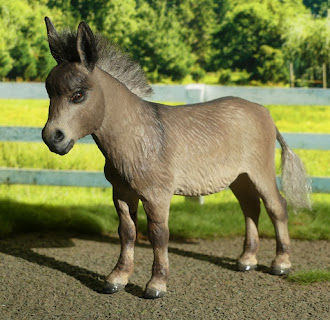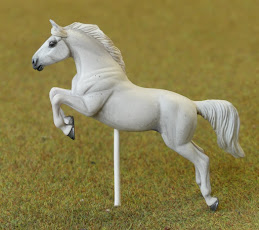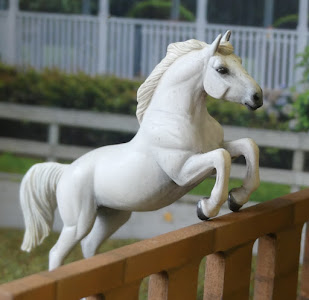In
my previous post on Magpie Models, I mentioned that I'd been for a rummage through another area of body box, and found not only the shells I
knew were in there, but an extra
donkey shell I didn't even remember buying!
Any model collectors reading this without being an enthusiast of Magpie might not know just
how sought after these rare donkeys are - I've seen an OF sell on ebay for over £130, and even blank shells making upwards of £50 each on a good day, so to say I was pleased to find I owned one more than I remembered is an understatement!
It's possible the extra one was a lucky find on a sales table at a live show some time before the prices started to rocket up (I wouldn't have paid more than about a fiver per body), and tucked away with the other shells to do something with later - then I promptly forgot about them entirely for however long, heh
With my Magpie collecting enjoying something of a renaissance with the photo show re-igniting my old love of my existing herd, and my new welshie customs turning out so nicely, I was on a roll and just couldn't resist getting to work on the first donkey.
As I've already got Julips of the two donkeys I used to look after for their owner, I decided to go with the colour of a different donkey I'm only vaguely acquainted with - I cycle past his corner paddock every time I go to work or to my own ponies. I started to call out 'hello, donkey' so I didn't make him jump by suddenly appearing on my bike, now it's become a habit to always greet him, and he always stops what he's doing to watch me go by.
I really like the way he turned out, the textured hairy-coat sculpting had me worried that with my brush-smudging painting technique the shading would catch on all the raised areas, leaving a rough patchy look, but he's just smooth enough that it wasn't an issue. I've named him Harecroft Tholomas (pronounced 'toller-muss').
Making his tail was the hardest part of the whole customisation process. I admit I hate working with the combination of glue and mohair at the best of times, so my usual tactic is to sew it into a sandwich of paper for a mane, and make a tight ponytail with a bit of wire wrapping for a tail, and slot them in without gluing just to avoid the ruining mess!
Adapting to a donkey mane was fine, as it's the same construction as a horse's mane, just trimmed to stand upright, and coloured with a bit of diluted black paint to dye it streaky. But for a donkey's distinctive tail anatomy, where the dock has the same short smooth coat as the body, I had to use glue to bundle the top half tight together, leaving just the fluffy tuft at the end. Once the PVA had dried completely, I attached it to his bum with a dot of gel superglue to make sure it's extra firm and can't drop off, and used a bit of paint to match the colour.
You'd think one new Magpie for my herd would be enough, but no, it seems now I've started I can't leave them alone ...I'll go back to have another look in the body box.
Magpie bodies come in matching halves to join together yourself, that's why we call them shells, and in here there's four pieces - enough to make two ponies.
Well, I have an actual shetland pony. So, even though I got
my Julip of her only last month, I suppose it's somehow inevitable and only right that my first shetland shell should be used as a portrait of my own shetland, and the second shell can become a made-up one in a colour I just fancy painting.
And here she is!
Bonnie has a notoriously difficult colour to paint, but I managed it using some golden beige shades, with a hint of 'chestnut' paint mixed in to deepen the colour without losing the warmth, then a little black and stoney grey-brown added for her legs, with the colour fading up into her hindquarters.
Exactly as with her Julip self, I chose her in-between coat colour - not the darkest chocolatey brown of her midsummer coat, or the much blonder winter fluff, but the golden shaded tones she goes twice every year. One of these days I'll have to do a winter Bonnie SM, but I'll need to resculpt the entire surface with rough thick fur first!

I'm really happy with how she turned out - I did think maybe it was a bit silly to paint myself a Bonnie so soon after getting her done as a Julip portrait, especially as shetland shells haven't been in production since the early 90s so they're almost as scarce as the donkeys. But Magpies are very different models and I'm sure I'll enjoy owning both of them - it's not a waste of the precious shell at all, but the best way I could possibly have used one up.
Here's a little before-and-after comparison, you can see that I did a little Milliputting work to reshape the face before painting.
It has incredibly tiny ears, which would just be lost amongst Bonnie's blonde forelock, so I made them about twice the size. Then I decided I may as well make it look even more like Bon and tweak some of the less pretty aspects of the face, so I enlarged the eyes, which weren't bad but were on the small side, and redid the muzzle chunkier, with larger nostrils and a closed mouth.
The original mouth is sculpted in a rather odd open-lips, gritted-teeth expression - I wonder if they were intended to be cut open to take a bit, like the Magpie arab and hunter can.
Bonnie's mane presented a challenge - I only have black, white or mixed black'n'white mohair, so I made up a plain white mane by sewing to avoid glue as usual, then used paint to colour it blonde with a hint of chestnut and some grey at the shoulder. It's still a tiny bit damp from styling mouse in this photo, but I forgot to take a better shot of her wrong side the next day when the sun came out!
Bonnie with her real self!
I've had to name this one Bonnie Surprise, her passport name which we never actually use, because I already used just plain Bonnie for the CollectA custom which was my first model of her, Little Bonnie for her Stablemate self, then chose Bonnie Bunny for the Julip after the real one's nickname (as well as having a Bonnie Scotland who was a lookalike Julip of a totally different Bonnie I used to ride, and had to have her name adjusted after my Bonnie arrived!)
I just have to
remember who got which name variation if I'm entering this herd of Bonnies in any photo shows.















































